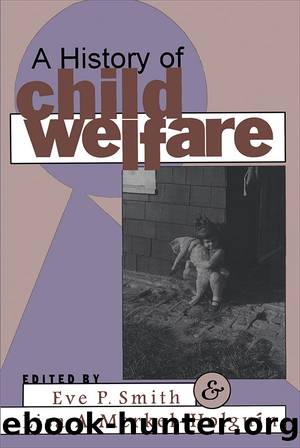A History of Child Welfare by Lisa Merkel-Holguin

Author:Lisa Merkel-Holguin [Merkel-Holguin, Lisa]
Language: eng
Format: epub
Tags: Public Policy, Political Science, General, Social Services & Welfare
ISBN: 9781351315906
Google: xfhADwAAQBAJ
Goodreads: 36984776
Publisher: Routledge
Published: 2017-11-30T00:00:00+00:00
Indenture and the Rise of Orphan Asylums
In the eighteenth century, local government officials known as the overseers of the poor were charged with distributing poor relief. These officials had the authority to indenture children from poor families in lieu of providing relief, and they did so regularly. In the colonial era, the duties of masters under indenture were spelled out in practical terms: children were to be fed, clothed, housed, and taught skills. Some children were taught to read and write, but education was not a universal component of indenture contracts. The indenture relationship was primarily economic rather than emotional or psychological in nature [Folks 1900; Kelso 1922; Mintz & Kellogg 1988].
Though many impoverished children were indentured by public officials, some parents entered into indenture agreements without any government involvement. Although used as a placement for children from low-income families, indenture in colonial America was by no means limited to children of the poor. It was commonplace for children from families that were not poor to be sent to other peopleâs homes at the age of 13 or 14. Sometimes a formal contract of indenture was drawn up; in other cases the arrangement was informal [Mintz & Kellogg 1988; Cray 1988].
In the first few decades of the nineteenth century, an urban middle class emerged with a new conception of childhood as a distinct phase of human development. Childrenâs characters were to be shaped not by breaking their wills as in the colonial era, but by leading them to internalize beliefs about behavior and morality [Ryan 1981]. Consequently, children stayed at home longer, and child-rearing methods changed.
By the early nineteenth century, indenture was no longer used by all classes; only children from low-income families were indentured. Public officials continued to indenture orphans, half-orphans, and other dependent children whose parents were unable to provide for them or were for some reason deemed unfit. Masters had to meet somewhat higher expectations about what to provide apprentices. For example, after Pennsylvania established free public schooling in 1834, masters were legally required to supply indentured children with âthree months schoolingâ each year [Heffner 1913: 146]. Although still widely used, indenture was clearly on the wane by the middle of the nineteenth century. Indenture contracts were still employed on occasion in the early twentieth century, but they were a rarity, having been gradually supplanted by other child welfare services half a century earlier.
In a reaction to the cholera epidemic of 1832 and poverty in the nationâs rapidly growing urban centers, numerous religious and charitable organizations founded orphan asylums. Although institutional care has often been seen as competing with indenture and other plans that place children with families, in practice the services were often used conjointly. Many orphan asylum superintendents placed small children with families where they would receive more individual attention than was possible in an asylum. Asylums also indentured older children in the hope that they would learn a trade, although by the late nineteenth century asylums were increasingly likely to provide some form of manual training within the institution itself [Porter 1984; Hacsi 1993].
Download
This site does not store any files on its server. We only index and link to content provided by other sites. Please contact the content providers to delete copyright contents if any and email us, we'll remove relevant links or contents immediately.
The Secret History by Donna Tartt(18846)
The Social Justice Warrior Handbook by Lisa De Pasquale(12141)
Thirteen Reasons Why by Jay Asher(8796)
This Is How You Lose Her by Junot Diaz(6794)
Weapons of Math Destruction by Cathy O'Neil(6146)
Zero to One by Peter Thiel(5686)
Beartown by Fredrik Backman(5599)
The Myth of the Strong Leader by Archie Brown(5425)
The Fire Next Time by James Baldwin(5249)
How Democracies Die by Steven Levitsky & Daniel Ziblatt(5128)
Promise Me, Dad by Joe Biden(5087)
Stone's Rules by Roger Stone(5026)
A Higher Loyalty: Truth, Lies, and Leadership by James Comey(4844)
100 Deadly Skills by Clint Emerson(4840)
Rise and Kill First by Ronen Bergman(4704)
Secrecy World by Jake Bernstein(4646)
The David Icke Guide to the Global Conspiracy (and how to end it) by David Icke(4625)
The Farm by Tom Rob Smith(4437)
The Doomsday Machine by Daniel Ellsberg(4416)
